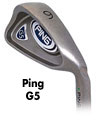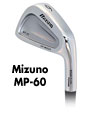The New Club Categories
If you've been following the evolution of iron technology in the last few years you know that there has been some new classifications of irons based on their forgiveness. Golf Digest, in it's latest Hot List club evaluations, divided irons into three categories; Super Game Improvement, Game Improvement and Players clubs.
Here's how they categorized some of the more popular clubs.
Super Game Improvement
In the Super Game Improvement category you'll find the Callaway Big Bertha irons, the Nike Slingshot OSS, and the TaylorMade r7 CBG.
Game Improvement
In the Game Improvement category you'll find the Ping G5, the Callaway X-18, and the Nike Slingshot Tour.
Players Clubs
In the Players category Golf Digest has the Mizuno MP-60, the Cleveland CG2, and the Callaway X-Tour.
Game Improvement Features
So what features make a club Super Game Improvement versus Game Improvement for example? And how do those features translate into forgiveness?
A golfer who needs maximum forgiveness wants clubs that still go straight and far when he hits the ball on someplace other than the center of the face. Moving weight to the perimeter of a club face makes these mishits more solid. Perimeter weighting also increases the Moment of Inertia (MOI) which means the club head will be more resistent to twisting on mishits. The more weight that is moved, the more forgiving the club will be, and the more super the game improvement.
If the center of gravity of the club is low and far back from the face, the ball will have a tendency to fly higher. This helps folks with slow swing speeds or golfers who have a hard time getting the ball up in the air. The farther and lower the CG, the more game improvement.
An offset hosel moves the leading edge of the club farther back from the shaft. This helps average golfers square the clubface at impact and not hit shots that leak to the right. The degree of offset determines it's forgiveness and its improvement category.
So to summarize, Super Game Improvement clubs feature extra-wide soles to help prevent digging, thick top lines to inspire confidence at address, tons of perimeter weighting to mitigate mishits, lots of offset to keep the clubface square and a low-back center of gravity to help get the ball up. Less of each of these features moves the club to a lower game improvement category.
So how do you find clubs that fall into these categories?
If you're in the market for golf clubs and want to save money you're probably considering custom clubs. Custom clubs use the same technology and materials as name brands and you can save a lot of money. But determining how custom clubs align with the three types of club forgiveness can be a little harder to figure out.
With some help from GigaGolf, we did an analysis to see how their irons fit into these three categories of forgiveness. Here's the results.




Model
Super Game Improvement
Game Improvement
Players Clubs
Hollow Core
Mid-Launch
Type-R
Type-S
Type-S HT
905 Tour
Dual Iron